
Credit: Hans Ollermann, via Wikimedia Commons
Mesopotamia, in the Middle East, is known as the birthplace of civilization. Two of its early civilizations mysteriously collapsed, which baffled researchers until they found the reason—in stalagmites.
Around 10,000 years ago, hunter-gatherers there developed agriculture and domesticated animals. Abundant food and animal labor allowed them time to invent: the wheel, glassmaking, and eventually writing.
This set the stage for the world’s first empires: the Akkadians then the Neo-Assyrians controlled all of Mesopotamia, though a thousand years apart. And both suddenly vanished.
Recently, some geologists went looking for clues in the region’s caves.
Water, dripping from the cave ceiling to the floor, carries minerals from the world above. Over centuries, the minerals solidify to form stalagmites, in layers like tree rings. By carefully analyzing each layer, the geologists discovered the kingdoms’ fates.
When both empires rose and thrived, the stalagmites were growing rapidly—indicating abundant groundwater from years of good rainfall, which brought plentiful crops.
Their collapses coincided with slow stalagmite growth and thin mineral layers high in magnesium—indicating scarce rainfall and frequent dust storms.
Both kingdoms were brought down by centuries-long drought.
In this and other ways, geologists are helping to understand extreme climates of the past.
Background
Synopsis: Mesopotamia has been called the cradle of civilization and was home to the Sumerians, Akkadians, Babylonians and Assyrians from 2400 BC to 600 BC. Two of these mighty empires crumbled suddenly. Stalagmites from caves in Iran and Iraq tell the tale of the collapse of the Akkadian Empire in 2154 BC and the Assyrian civilization around 605 BC because of regional drought and dust storms that shut down their agrarian civilizations.
- Mesopotamia is a region that includes today’s eastern Syria, southeastern Turkey, most of Iraq, western Iran and Kuwait.
- The word Mesopotamia comes from a Greek word that means between rivers, referring to the floodplains of the Euphrates and Tigris Rivers.
- The region is the eastern part of the Fertile Crescent that ranges from the Nile River, along the eastern Mediterranean coast, through Mesopotamia to the Arabian (Persian) Gulf.
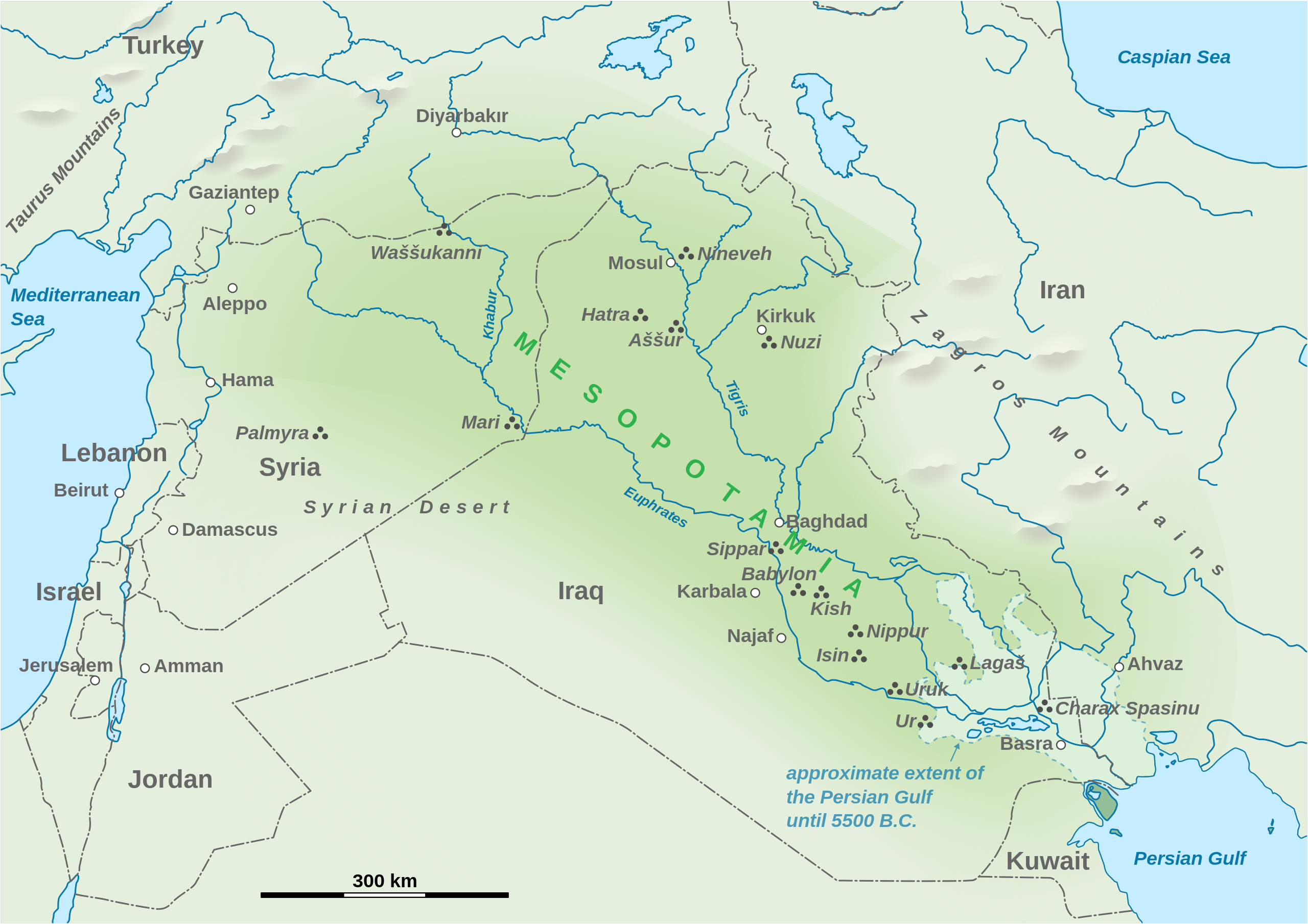
Map of Mesopotamia with modern cities shown as open white dots and ancient cities shown in triple dots. The Akkadian Empire was centered in the southeast near the Arabian (Persian) Gulf in present day southern Iraq and western Iran, while the Assyrian civilization was concentrated in the northwest near present day northern Iraq, Syria and Turkey.
Credit: Goran tek-en, via Wikimedia Commons
- The region is referred to as a cradle of civilization because the bounty of the land enabled the emergence of settled farming with domesticated crops and irrigation.
- As agrarian civilization freed individuals from hunter-gatherer existences, populations thrived and diversified.
- Technological advances followed, including writing, the wheel and glassmaking.
- In the late Neolithic and early Bronze Age, the region was home to series of great empires, two of which collapsed suddenly and mysteriously.
- Early Neolithic hunter-gatherers lived in the foothills of the Taurus and Zagros Mountains, developing agricultural practices before 8700 BC, domesticating animals before 6800 BC, and building communal monuments such as Göbekli Tepe in southeastern Turkey.
- Around 3200 BC cuneiform writing was invented by the Uruk people at the start of the Bronze Age.
- From 2334–2154 BC, the Akkadian Empire grew to prominence, creating weirs and diversion dams to transport water, further increasing the wealth and breadth of the kingdom. Its first ruler, Sargon of Akkad, is considered to be the first ruler of an empire. His grandson Naram-Sin was the first ruler to claim he was divine. The empire lasted 180 years and then suddenly collapsed and was abandoned for about 300 years.
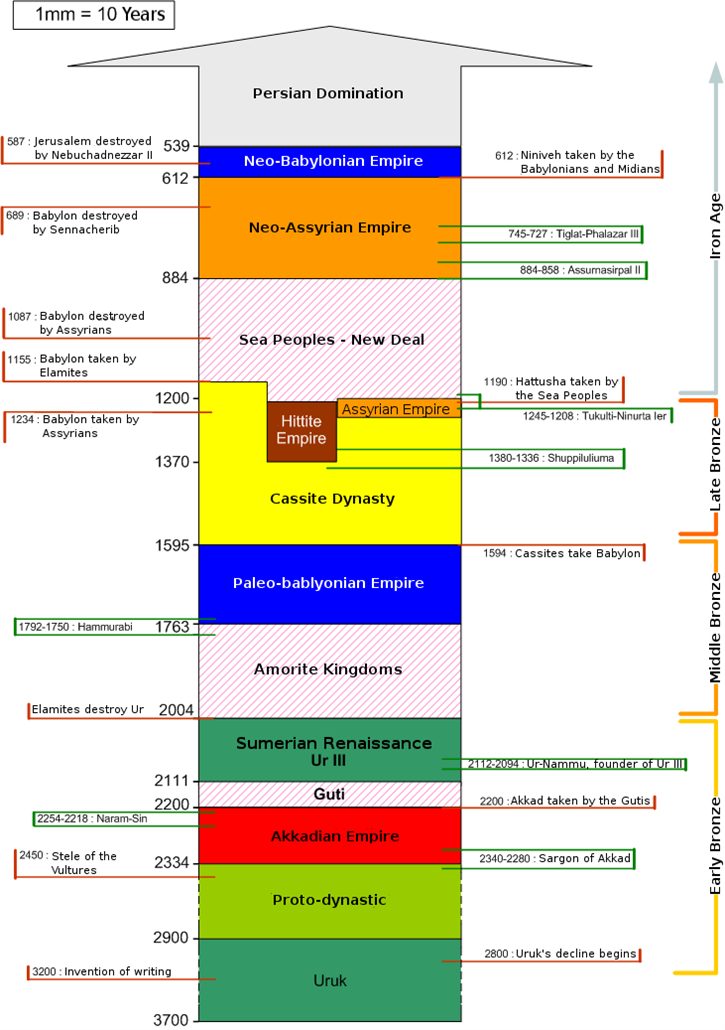
A schematic chronology of Mesopotamia shows the many empires of the region. The range of Bronze and Iron Ages is shown on the right.
Credit: Chronologie_Mesopotamie_2.png: VenalMesopotamian_Chronology_2.png: *Chronologie_Mesopotamie_2.png: Venalderivative work: SimonTrew (talk)derivative work: Ixalarx, via Wikimedia Commons - Other kingdoms and dynasties successively dominated the region, including the Sumerians, Amorites, Babylonians and Hittites, ushering in the Iron Age.
- In 884 BC, the Neo-Assyrian Empire took control, conquering Egypt and the Near East to become the largest Empire the world had seen. It collapsed suddenly 272 years later in 612 BC, leaving the capital of Nineveh abandoned for more than 100 years.
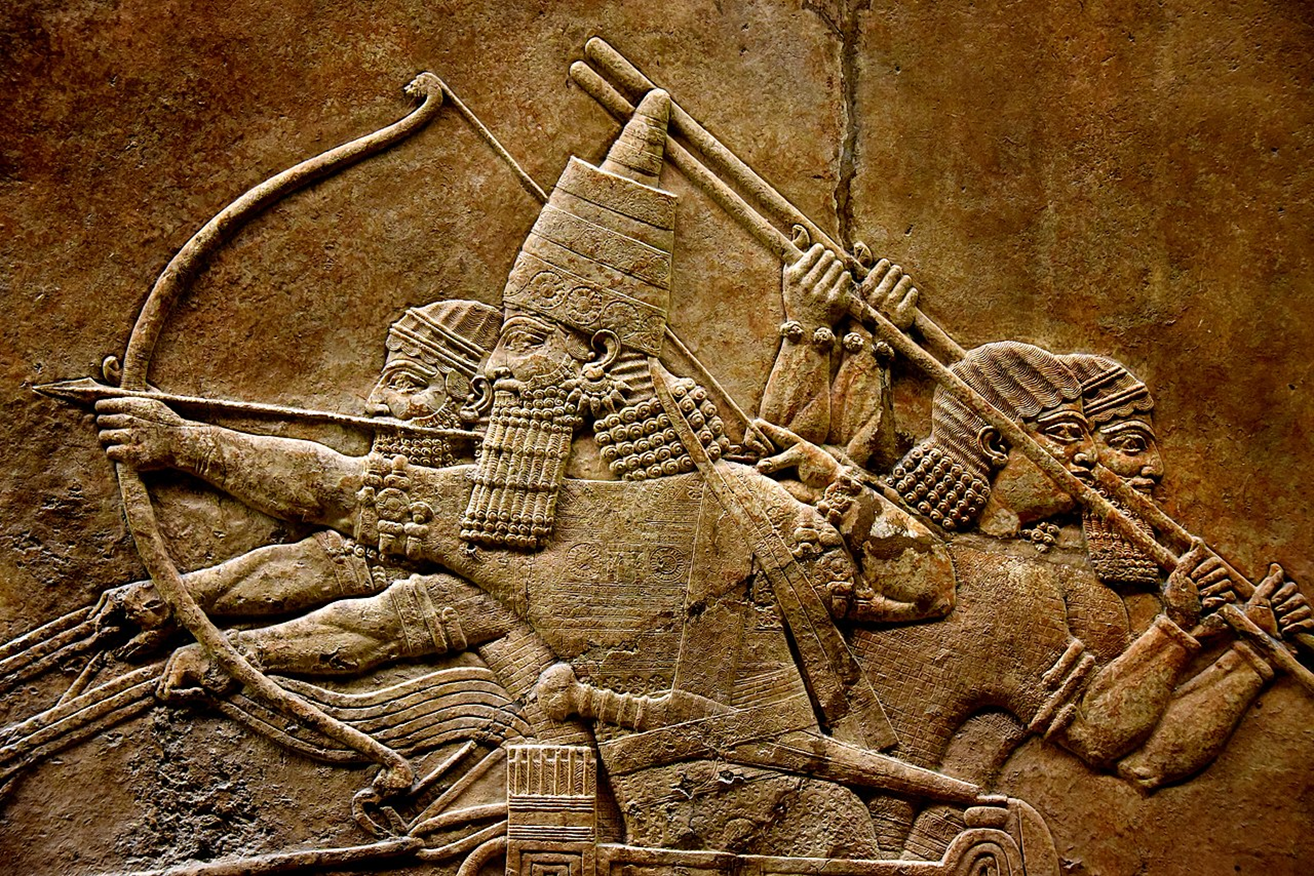
Detail of an alabaster bas-relief of a lion-hunt scene featuring King Ashurbanipal who ruled the Neo-Assyrian Empire from 669–631 BC and is thought of as the last great king of Assyria. It is from the North Palace at Nineveh, Iraq, and is currently displayed at The British Museum, London. The Neo-Assyrian Empire ruled Mesopotamia from 884–612 BC.
Credit: Osama Shukir Muhammed Amin FRCP(Glasg), via Wikimedia Commons - The Neo-Babylonians and Persians followed as the region was conquered by Alexander the Great in 334 BC.
- Through millennia of battles and conflict, most of the changes in power have been explained; however, the rapid decline of the Akkadians and Neo-Assyrians has long puzzled historians.
- Now geology has provided clues to both of these mysteries, using cave formations called stalagmites.
- Stalagmites and stalactites form in caves from the action of groundwater as it flows through carbonate rocks like limestones.
- As water percolates through soil, it picks up ions from air and soil and becomes mildly acidic. Limestone rocks dissolve in acid, so the water carries calcium carbonate.
- Stalactites form on the ceiling of a cave as water drips into caverns, precipitating to form limestone straws.
- Stalagmites occur below stalactites as the water drips onto the floor of the cave, creating a record of past water chemistry as it precipitates, building a column.
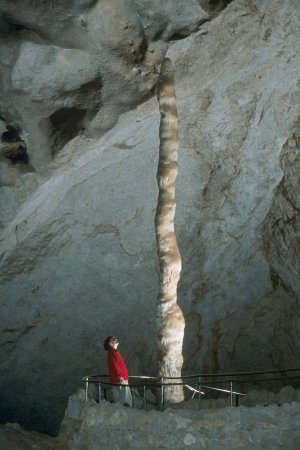
The Witch’s Fingers, a stalagmite in Carlsbad Caverns National Park in New Mexico.
Credit: Peter Jones, NPS
- Stalactite and stalagmite growth is governed by external temperature and rainfall. Their form depends upon how the water comes into the cave (seeping, dripping or splashing) and whether it ponds or flows away from the structure.
- Some stalagmites that form by regular dripping precipitate in rings, getting younger on the outside.
- In rainy areas, rings can be seasonal with annual cyclicity like tree rings, but in arid regions, they are less reliable, recording intermittent rainy periods.
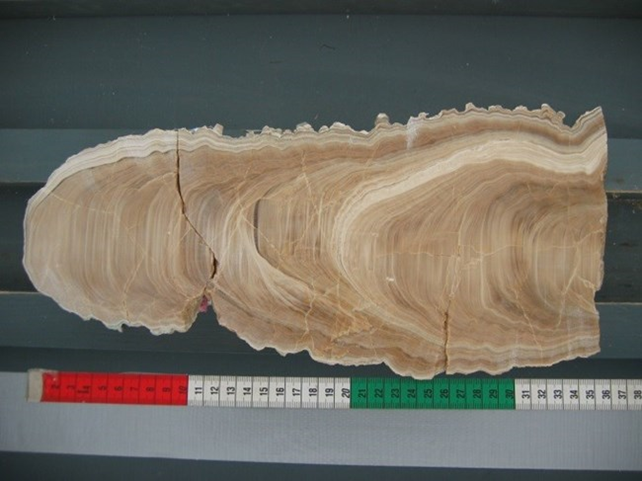
Note the rings in this stalagmite from Lehman Caves in Great Basin National Park, Nevada.
Credit: NPS - Scientists date stalagmite layers using uranium-thorium radiogenic dating, with error bars of a few decades.
- Recently, two separate studies of stalagmites in caves located in Iran and Iraq provided new clues about Bronze Age and Iron Age Mesopotamia.
- A stalagmite collected from Gol-e-Zard (Yellow Flower) Cave near Tehran, Iran, exhibits unusual layers rich in magnesium. Ages were determined with an error bar of 31 years.
- The stalagmite grew for 15 centuries from 3178 BC through 1678 BC, from around the time writing was invented through the Akkadian Empire and into the Middle Bronze Age.
- Magnesium rich layers indicating high concentrations of dust have been dated, coinciding with the abandonment of Akkadian settlements.
- The duration of the magnesium enriched layers is 290 years, matching the long interval without evidence of settlement in the region.
- Marine core from the Gulf of Oman also demonstrates increased dust activity at the time. Prevailing winds blew dust long distances away from Mesopotamia.
- Geoscientists and archaeologists believe the new data suggest that an abrupt change to a drier climate characterized by nearly 300 years of dust storms may have contributed to the downfall of the highly successful agrarian Akkadian civilization.
- From Kuna Ba Cave in northeastern Iraq, another stalagmite provides a picture of a different time in history, when history repeated itself.
- The cave is located across the Tigris River from the ancient Assyrian capital of Nineveh about 300 miles southeast of Mosul, Iraq.
- A 4000-year climate history was constructed from the stalagmite samples using ratios of oxygen and uranium isotopes, which are sensitive to changes in temperature and rainfall.
- Geoscientists and archaeologists aligned the climate records with written records and found that the height of the Neo-Assyrian Empire occurred during a rainy 200-year “megapluvial” period that lasted from 925 to 725 BC.
- That time of plenty was followed by an extreme 125-year drought from 675 to 550 BC, during which Nineveh was abandoned.
- Once again, a successful Mesopotamian agrarian society was brought down by abrupt climate change.
- Scientists studying stalagmites from Lehman Caves in Nevada’s Great Basin National Park have made an important related discovery in the American Southwest.
- Stalagmites from the caves have provided a climate record for 175,000 years that shows a dry to wet cycle that consistently lasts 21,000 years.
- About 1,600 years ago, the region entered a warm dry period, and it is expected to continue to get drier, following the established 21,000-year cycle.
- However, this new cycle became warmer and drier faster than any of the past cycles, which doesn’t bode well for the American West in a warming climate.

